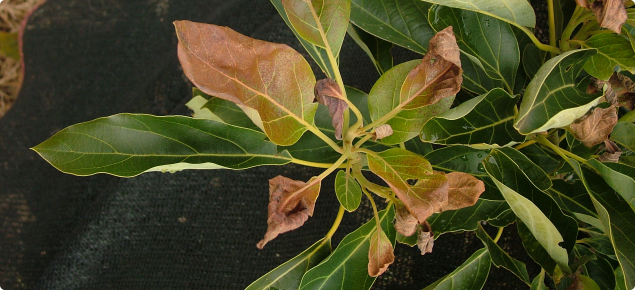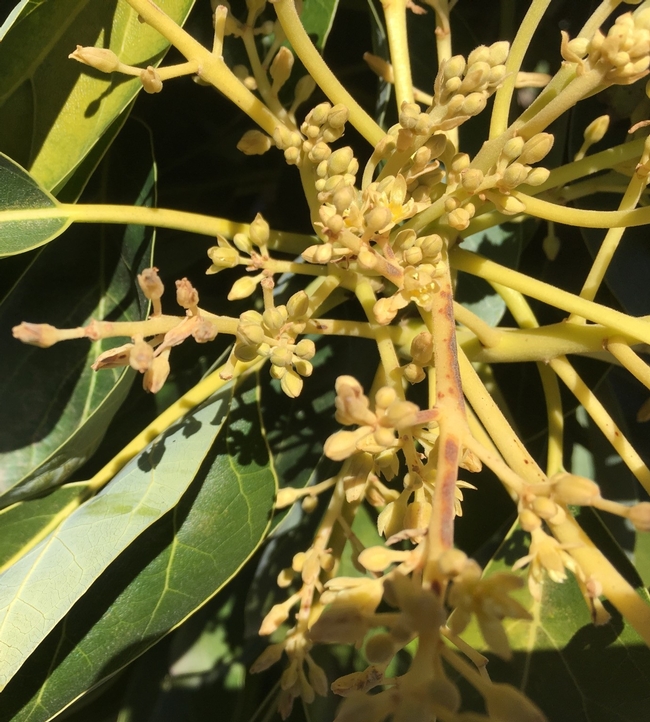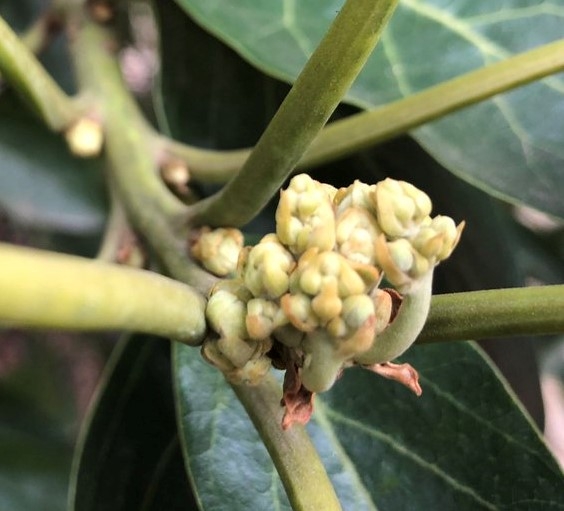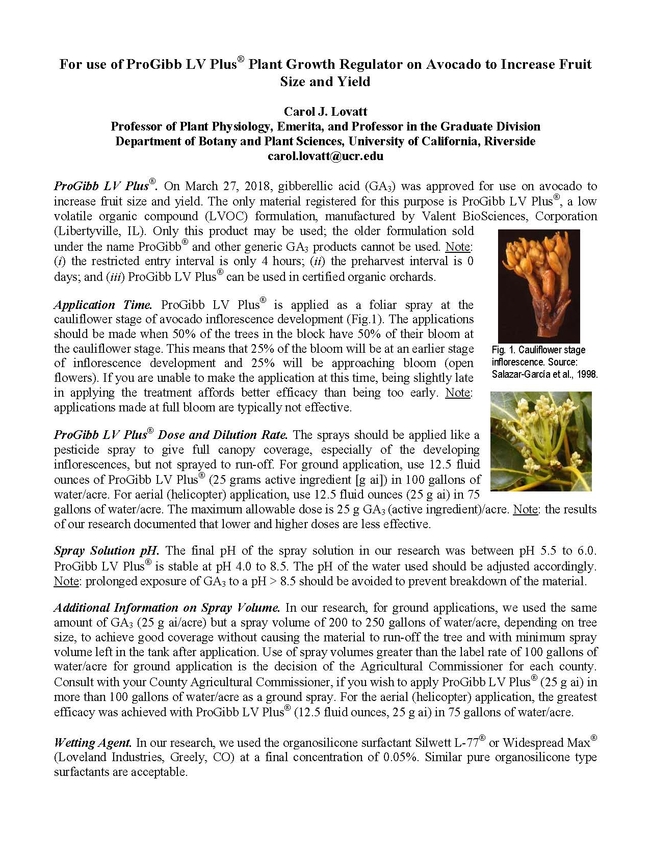
Posts Tagged: gibb
Time to Gibb Avocados?
Avocados in some parts of coastal California have been blooming. Some of them got hit by the cold weather in the first part of February. In the coldest areas there was a little bit of new leaf damage, but this has been minimal.
Some browning of some flowers and stems (pedicels - the little stalks the connect the flowers to the larger raceme/panicle) may have occurred, but I haven't heard of major flower damage.
It's early days for flowering, though, and most ‘Hass' trees are not very far along, but seem like they area about to burst. A recent visit on a 40 acre farm in Saticoy had trees in a whole range of stages, some with no flowers pushing, some with panicles just starting to open individual flowers and many trees on their north sides' completely quiet. Many are still just pushing into the cauliflower stage,
which is the ideal time is for applying Pro-Gibb to improve fruit set in healthy orchards.
Application time is when 50% of the trees in the block have 50% of their bloom in the cauliflower stage. This is a judgment call when there can be such huge variation in bloom across and orchard. It's going to be a best estimate call for when to do the application. As usual with a new technology/practice don't apply to the whole orchard so that you can see whether the application is warranted.
For a more detailed discussion of gibb application, read Carol Lovatt's article:

avocado flowers 2
Frosted Flowers? Still Time to Gibb
Avocados in some parts of coastal California have been blooming. Some of them got hit by the cold weather in the first part of February. In the coldest areas there was a little bit of new leaf damage, but this has been minimal.
Some browning of some flowers and stems (pedicels - the little stalks the connect the flowers to the larger raceme/panicle) may have occurred, but I haven't heard of major flower damage.
It's early days for flowering, though, and most ‘Hass' trees are not very far along, but seem like they area about to burst. A recent visit on a 40 acre farm in Saticoy had trees in a whole range of stages, some with no flowers pushing, some with panicles just starting to open individual flowers and many trees on their north sides' completely quiet. Many are still just pushing into the cauliflower stage,
which is the ideal time is for applying Pro-Gibb to improve fruit set in healthy orchards.
Application time is when 50% of the trees in the block have 50% of their bloom in the cauliflower stage. This is a judgment call when there can be such huge variation in bloom across and orchard. It's going to be a best estimate call for when to do the application. As usual with a new technology/practice don't apply to the whole orchard so that you can see whether the application is warranted.
For a more detailed discussion of gibb application, read Carol Lovatt's article:
Make More Avocado Fruit
At a recent grower meeting at South Coast Research and Extension Center in Irvine, Carol Lovatt gave a talk on the use of gibberellic acid to increase avocado fruit set and yield. The registration for the use only occurred this spring, barely in time for growers to use it, so not many applied it. Then we had this heat wave in July and a lot of fruit, whether it had been treated or not, fell off. A show of hands was asked of the growers present, who had applied it this spring. Of the 100 people or so in attendance, only five raised their hands. Of course, this is not a scientific survey, but most would try it again this coming spring, even though they might not have seen results this year.
The following are guidelines that were provided on how to use it, if you should so choose this coming spring:
Use of ProGibb LV PlusR Plant Growth Regulator on Avocado to Increase Fruit Size and Yield
Carol Lovatt
Professor of Plant Physiology, Emerita, and Professor in the Graduate Division, Department of Botany and Plant Sciences, University of California, Riverside carol.lovatt@ucr.edu
ProGibb LV PlusR. On March 27, 2018, gibberellic acid (GA3) was approved for use on avocado to increase fruit size and yield. The only material registered for this purpose is ProGibb LV PlusR, a low volatile organic compound (LVOC) formulation, manufactured by Valent BioSciences, Corporation (Libertyville, IL). Only this product may be used; the older formulation sold under the name ProGibbR and other generic GA3 products cannot be used. Note: (i)the restricted entry interval is only 4 hours; (ii) the preharvest interval is 0 days; and (iii) ProGibb LV PlusÒ can be used in certified organic orchards.
Application Time. ProGibb LV PlusR is applied as a foliar spray at the cauliflower stage of avocado inflorescence development. The applications should be made when 50% of the trees in the block have 50% of their bloom at the cauliflower stage. This means that 25% of the bloom will be at an earlier stage of inflorescence development and 25% will be approaching bloom (open flowers). If you are unable to make the application at this time, being slightly late in applying the treatment affords better efficacy than being too early. Note: applications made at full bloom are typically not effective.
ProGibb LV PlusR Dose and Dilution Rate. The sprays should be applied like a pesticide spray to give full canopy coverage, especially of the developing inflorescences, but not sprayed to run-off. For ground application, use 12.5 fluid ounces of ProGibb LV PlusR (25 grams active ingredient [g ai]) in 100 gallons of water/acre. For aerial (helicopter) application, use 12.5 fluid ounces (25 g ai) in 75 gallons of water /acre. The maximum allowable dose is 25 g GA3 (active ingredient)/acre. Note: the results of our research documented that lower and higher doses are less effective.
Spray Solution pH. The final pH of the spray solution in our research was between pH 5.5 to 6.0. ProGibb LV PlusR is stable at pH 4.0 to 8.5. The pH of the water used should be adjusted accordingly. Note: prolonged exposure of GA3 to a pH > 8.5 should be avoided to prevent breakdown of the material.
Additional Information on Spray Volume. In our research, for ground applications, we used the same amount of GA3 (25 g ai/acre) but a spray volume of 200 to 250 gallons of water/acre, depending on tree size, to achieve good coverage without causing the material to run-off the tree and with minimum spray volume left in the tank after application. Use of spray volumes greater than label rate of 100 gallons of water/acre for ground application is the decision of the Agricultural Commissioner for each county. Consult with your County Agricultural Commissioner, if you wish to apply ProGibb LV PlusR (25 g ai) in more than 100 gallons of water/acre as a ground spray. For the aerial (helicopter) application, the greatest efficacy was achieved with ProGibb LV PlusR (12.5 fluid ounces, 25 g ai) in 75 gallons of water/ acre.
Wetting Agent. In our research, we used the organosilicone surfactant Silwett L-77R or Widespread MaxR (Loveland Industries, Greely, CO) at a final concentration of 0.05%. Similar pure organosilicone type surfactants are acceptable.
Photo: Cauliflower stage inflorescence. Source: Salazar-García et al., 1998.
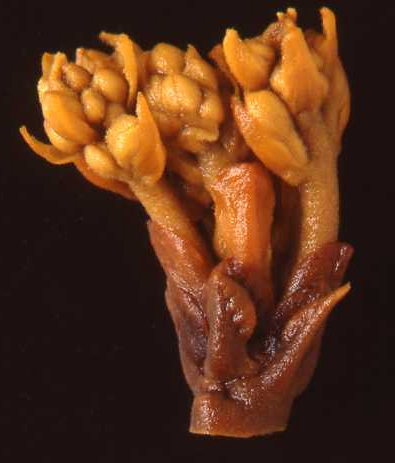
avocado cauliflower stage
Make More Avocado Fruit
Use of ProgGibb LV Plus® Plant Growth Regulator Increases Total Yield/ Fruit Size of Hass Avocados
As of March 27, 2018, foliar application of GA3 (ProGibb LV Plus®, Valent BioSciences, Corp.) to ‘Hass' avocado trees in commercial orchards has been approved. Dr. Carol J. Lovatt, emerita professor of plant physiology at the University of California – Riverside, recently completed research concerning the effectiveness of ProGibb LV Plus® on avocado fruit size and yield. A summary of her research — including best practices — follows.
Application Best Practices
ProGibb LV Plus® should be applied as a foliar spray when 50 percent of the trees in a block are at the cauliflower stage of inflorescence. If a grower cannot make an application at this time, it is best to apply the spray later, rather than earlier in order to ensure effectiveness.
The spray should be applied like a pesticide spray — full canopy coverage with a focus on the inflorescences. Those applying the spray should avoid spraying to run-off.
The ideal dilution for ground application is 12.5 fluid ounces of ProGibb LV Plus® (25 grams active ingredient [gai]) per 100 gallons of water/acre. For aerial application, use 12.5 fluid ounces (25 gai) in 75 gallons of water/acre. According to the research, the ideal application rate is 25g GA3 per acre; higher and lower doses were less effective. The pH of the water used should be adjusted such that the final pH of the spray solution is between pH 5.5 – 6.0.
Dr. Lovatt utilized organosilicone surfactant Silwett L-77® or Widespread Max® at a concentration of 0.05 percent as a wetting agent. Similar pure organosilicone type surfactants would be acceptable as wetting agents. It is important to note that until additional research can be conducted, other materials should not be included in the ProGibb LV Plus® spray solution.
Effect of ProGibb LV Plus® (GA3)
Dr. Lovatt's research team tested the effect of ProGibb LV Plus® on fruit size and yield for both ground and aerial applications. Overall, the research team noted that GA3 had no negative effects on ‘Hass' avocado fruit quality.
Ground applications were tested in March at groves located in Corona, Irvine and Somis, California. The tests were run on Duke 7 clonal rootstock trees at the cauliflower stage of inflorescence development. Each of the groves reported net increases in total yield and large/commercially valuable size fruit. The results were as follows:
Table 1. Effect of GA3 (25 g ai/acre) applied at the cauliflower stage of inflorescence development on yield and fruit size (pounds/tree) of ‘Hass' avocado trees in Corona, CA.
| Treatment | Total Fruit | Net Increase (%) | Large fruit (213-354 g/fruit) | Net increase (%) |
|---|---|---|---|---|
| lb fruit/tree | ||||
| GA3 | 74.7 az | 84 | 34.3 a | 128 |
| Control | 40.6 b | 15.0 b | ||
| P-value | 0.0997 | 0.0657 | ||
z Values in a vertical column followed by different letters are significantly different at specified P-values by Duncan's Multiple Range Test at the P-values indicated. (From the work of Salazar-García and Lovatt, 2000).
Table 2. Effect of GA3 (25 g ai/acre) applied at the cauliflower stage of inflorescence development on yield and fruit size as pounds and number of fruit per tree in an alternate bearing ‘Hass' avocado orchard in Irvine, CA.
| Year 1 Yield | ||||
|---|---|---|---|---|
| Treatment | Total Fruit | Net Increase (%) | Valuable Size Fruit (178-325 g/fruit) | Net increase (%) |
| GA3 | 92.2 az | 70 | 67.9 a | 65 |
| Control | 54.2 b | 41.2 b | ||
| P-value | 0.0029 | 0.0037 | ||
| GA3 | 215 a | 76 | 141 a | 70 |
| Control | 122 b | 83 b | ||
| P-value | 0.0042 | 0.0026 | ||
z Values in a vertical column followed by different letters are significantly different at specified P-values by Duncan's Multiple Range Test at the P-values indicated. (From the work of Lovatt and Salazar-García, 2007; Zheng et al., 2011)
Table 3. Effect of GA3 (25 g ai/acre) applied at the cauliflower stage of inflorescence development at on yield and fruit size of ‘Hass' avocado trees in Somis, CA. Percent net increase reflects the benefit of GA3 at 25 g ai/acre relative to the untreated control trees.
| Treatment | Total Fruit | Net Increase (%) | Valuable size fruit (178-325 g/fruit) | Net increase (%) | Large fruit (213-354 g/fruit) | Net increase (%) |
|---|---|---|---|---|---|---|
| lb fruit/tree | ||||||
| GA3 | 408.1 az | 10 | 379.4 a | 13 | 294.1 a | 16 |
| Control | 372.6 b | 335.3 b | 253.3 b | |||
| P-value | 0.0626 | 0.0252 | 0.0626 | |||
z Values in a vertical column followed by different letters are significantly different by Fisher's Protected LSD test at the P-values indicated.
Overall, ground application of GA3 resulted in a net increase of 3,905 lb/acre, with a net increase of 4,851 lb/acre of commercially valuable size fruit (packing carton sizes 60+48+40; 178-325 g/fruit) and a net increase in large fruit (packing carton sizes 48+40+36; 213-354 g/fruit) of 4,488 lb/acre.
Aerial applications were tested on groves located in Pauma Valley and Carpinteria, California. Together, the aerial applications demonstrated that GA3 increased fruit set (fruit retention) by 55 percent into the last week of August and fruit size by 6 percent through mid-August.
Ultimately, Dr. Lovatt's research indicates that use of GA3 could result in substantial increases in net dollar return per acre to the grower due to increase in yield and commercially valuable size fruit. In addition, growers whose avocado groves are not suited to ground applications (groves located on slopes or in high-density formations) can benefit from the efficacy of utilizing aerial applications. In summary, ProGibb LV Plus® is “vital to the California avocado industry to increase grower income per acre to help sustain the California avocado industry.”
N.B. Remember, only well managed trees are going to respond. This will not turn around a poor producing orchard. only potentially increase production on an already good producing orchard. Ben

avocado fruit

